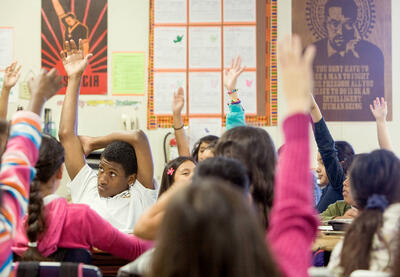When tragedy strikes, educators consider their students first and foremost. Teachers want to know, “What do I tell my kids?” and, “How do I help students wrap their heads around such unthinkable violence?”
This week, students might ask their teachers to explain. They might lean on their teachers for proximate grounding and hope as they process this event.
This violence has also rattled adults. Rage, fear and despair cluster as the universal response to traumatic events. For adults, grief may also manifest as exhaustion with what feels like endless and increasingly frequent violence.
Educators must draw from an internal wellspring of emotional equilibrium to respond skillfully to youth. It’s helpful to try to achieve this balance before interacting with students about acts of violence and the emotional responses you’re weighing.
In the wake of violence, pause for a moment. Acknowledge and open yourself to any uneasiness and pain. Inquire into these anxieties, investigating them as they appear. Staying with the feelings allows you to strengthen yourself—the very strength needed to model resilience. Acutely perceptive, students will take note of this inner fortitude. They will tap into its healing quality and tone.
Tending to one’s inner landscape is messy. It takes courage to acknowledge a deep reservoir of needs. But doing the work will lead to a seasoned emotional stability that can equalize the urge to succumb to anxieties or lash out in rage. The inner work is worth it.
These practices can help you keep up your mental health hygiene. Try them out. They can help you demonstrate compassion and courage while interacting with your students, too.
Move
Violent events can leave one feeling overwhelmed, stagnated or even frozen. Connecting to the body pushes back against a framework of anger and hate. When intellectually engaging with the news media becomes too overwhelming, get physical. Dance, shake or stomp. Movement stimulates neurotransmitters like dopamine and serotonin, and shifts thought patterns that have become lodged in a groove.
Shift
If you are feeling heavy, sluggish or weighed down in response to the tragedy, do something to shift that feeling. This can be as simple as focusing on your breathing and watching it change or moving from lying down to sitting up. By shifting one’s bodily experience, a new emotional experience opens up.
Express
Once movement happens internally, it becomes easier to express the emotions lodged in the body. Paint, sing, collage, write or play. Expression creates an opening to interact with one’s experience in a concrete, physical way. In moments of collective grief, it is tempting to trap oneself in a train of ruminating questions, such as, “Why did this happen?” Use creativity to move away from “Why?” questions toward a more empowered stance that explores questions like, “What now?”
Connect
In reaction to violence, it is common to fixate on feeling powerless or hopeless. By connecting to external community, we connect to a broad network of available resources. Expanding awareness lifts one’s confidence, empowering teachers to mentor, lead and serve their students. We inhabit a reality of arbitrary, unanticipated violence and subsequent terror. Nonetheless, teachers are part of a shared global community. We are all stronger when we remember this.
Above all, employ generous amounts of gentleness and patience—with yourself first and foremost—so that these qualities will naturally radiate out toward your students. In this way, we create the supportive and healing classroom culture of which we all deeply strive to be a part.
Ehrenhalt is the school-based programming and grants manager with Learning for Justice.


0 COMMENTS